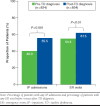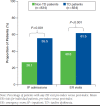Health Care Resource Utilization and Costs for Patients with Tardive Dyskinesia
- PMID: 31232207
- PMCID: PMC10398273
- DOI: 10.18553/jmcp.2019.25.7.810
Health Care Resource Utilization and Costs for Patients with Tardive Dyskinesia
Abstract
Background: Tardive dyskinesia (TD) is an often-irreversible movement disorder affecting any part of the body. Patients experience debilitating symptoms that lower quality of life and increase mortality. Prolonged exposure to dopamine antagonists, which are frequently prescribed for psychiatric disorders as neuroleptic (antipsychotic) drugs, is a common cause of TD. The estimated prevalence of TD is 20%-50% among patients on antipsychotics, and the reported incidence of TD ranges from < 1% to 42%, depending on the antipsychotics studied. However, there are few real-world studies examining health care utilization and the economic burden of TD.
Objective: To assess health care utilization and costs in a sample of patients with TD from the commercially insured and Medicare supplemental U.S.
Methods: A retrospective analysis was conducted using Truven MarketScan Commercial and Medicare administrative claims data. Patients were included in the TD group if they had the first TD diagnosis (index date) between January 1, 2008, and September 30, 2014, with ≥ 1 inpatient or ≥ 2 outpatient nondiagnostic claims for TD (ICD-9-CM code 333.85). Patients without TD were randomly assigned an index date. Further inclusion criteria for all patients were ≥ 12 months of pre- and post-index medical and pharmacy continuous enrollment and no evidence of TD claims during the pre-index period. Patients with TD were directly matched to patients without TD within subgroups for schizophrenia, major depressive disorder, bipolar disorder, and other psychiatric disorders and propensity matched on other demographic and clinical factors. Descriptive statistics on the incidence of resource utilization and costs of health care were reported.
Results: Of 3,397 patients with TD, 834 met the selection criteria and were matched to 834 non-TD controls. Patients with TD generally had significantly greater utilization during the 12 months after TD diagnosis than in the 12 months before TD diagnosis. Their rates for health care utilization and costs were also substantially higher than for those without TD. During the post-TD-diagnosis time, inpatient admissions (55.5% vs. 26.1%; P < 0.001) and emergency room visits (61.5% vs. 50.6%; P < 0.001) occurred more for patients with TD than for patients without TD. Total health care costs were significantly greater for patients with TD than for those without TD ($54,656 vs. $28,777; P < 0.001).
Conclusions: Patients diagnosed with TD demonstrate significantly higher health care utilization and costs compared with non-TD patients.
Disclosures: This study was funded by Teva Pharmaceuticals (Petach Tikva, Israel). Truven Health Analytics, an IBM Watson Health Company, received payment from Teva Pharmaceuticals for the analysis in this study. Carroll is employed by Teva Pharmaceuticals and Irwin is employed by Truven Health Analytics, an IBM Watson Health Company.
Conflict of interest statement
This study was funded by Teva Pharmaceuticals (Petach Tikva, Israel). Truven Health Analytics, an IBM Watson Health Company, received payment from Teva Pharmaceuticals for the analysis in this study. Carroll is employed by Teva Pharmaceuticals and Irwin is employed by Truven Health Analytics, an IBM Watson Health Company.
Figures
Similar articles
-
Treatment Patterns and Associated Health Care Costs Before and After Treatment Initiation Among Pulmonary Arterial Hypertension Patients in the United States.J Manag Care Spec Pharm. 2018 Aug;24(8):834-842. doi: 10.18553/jmcp.2018.17391. Epub 2018 Feb 13. J Manag Care Spec Pharm. 2018. PMID: 29436260 Free PMC article.
-
Health Care Utilization and Costs Associated with Endometriosis Among Women with Medicaid Insurance.J Manag Care Spec Pharm. 2019 May;25(5):566-572. doi: 10.18553/jmcp.2019.25.5.566. J Manag Care Spec Pharm. 2019. PMID: 31039061 Free PMC article.
-
Health Care Burden Associated with Outpatient Opioid Use Following Inpatient or Outpatient Surgery.J Manag Care Spec Pharm. 2019 Sep;25(9):973-983. doi: 10.18553/jmcp.2019.19055. Epub 2019 Jul 17. J Manag Care Spec Pharm. 2019. PMID: 31313621 Free PMC article.
-
Economic Burden of Treatment-Resistant Depression on the U.S. Health Care System.J Manag Care Spec Pharm. 2019 Jul;25(7):823-835. doi: 10.18553/jmcp.2019.25.7.823. J Manag Care Spec Pharm. 2019. PMID: 31232205 Free PMC article.
-
[Prevention and treatment of tardive dyskinesia caused by antipsychotic drugs].Encephale. 2016 Jun;42(3):248-54. doi: 10.1016/j.encep.2015.12.021. Epub 2016 Feb 26. Encephale. 2016. PMID: 26922134 Review. French.
Cited by
-
Tardive Dyskinesia in Older Persons Taking Antipsychotics.Neuropsychiatr Dis Treat. 2021 Oct 14;17:3127-3134. doi: 10.2147/NDT.S328301. eCollection 2021. Neuropsychiatr Dis Treat. 2021. PMID: 34703232 Free PMC article. Review.
-
Tardive dyskinesia in Asia- current clinical practice and the role of neurologists in the care pathway.Front Neurol. 2024 Feb 14;15:1356761. doi: 10.3389/fneur.2024.1356761. eCollection 2024. Front Neurol. 2024. PMID: 38419696 Free PMC article.
-
The Clinical and Economic Burden of Tardive Dyskinesia in Israel: Real-World Data Analysis.J Clin Psychopharmacol. 2022 Sep-Oct 01;42(5):454-460. doi: 10.1097/JCP.0000000000001597. Epub 2022 Aug 20. J Clin Psychopharmacol. 2022. PMID: 36018237 Free PMC article.
-
Deep Brain Stimulation in the Treatment of Tardive Dyskinesia.J Clin Med. 2023 Feb 27;12(5):1868. doi: 10.3390/jcm12051868. J Clin Med. 2023. PMID: 36902655 Free PMC article. Review.
-
Impact of possible tardive dyskinesia on physical wellness and social functioning: results from the real-world RE-KINECT study.J Patient Rep Outcomes. 2023 Mar 9;7(1):21. doi: 10.1186/s41687-023-00551-5. J Patient Rep Outcomes. 2023. PMID: 36892733 Free PMC article.
References
-
- Lerner PP, Miodownik C, Lerner V. Tardive dyskinesia (syndrome): current concept and modern approaches to its management. Psychiatry Clin Neurosci. 2015;69(6):321-34. - PubMed
-
- Aquino CC, Lang AE. Tardive dyskinesia syndromes: current concepts. Parkinsonism Relat Disord. 2014;20(Suppl 1):S113-17. - PubMed
-
- Browne S, Roe M, Lane A, et al. . Quality of life in schizophrenia: relationship to sociodemographic factors, symptomatology and tardive dyskinesia. Acta Psychiatr Scand. 1996;94(2):118-24. - PubMed
MeSH terms
Substances
LinkOut - more resources
Full Text Sources
Medical
Miscellaneous





